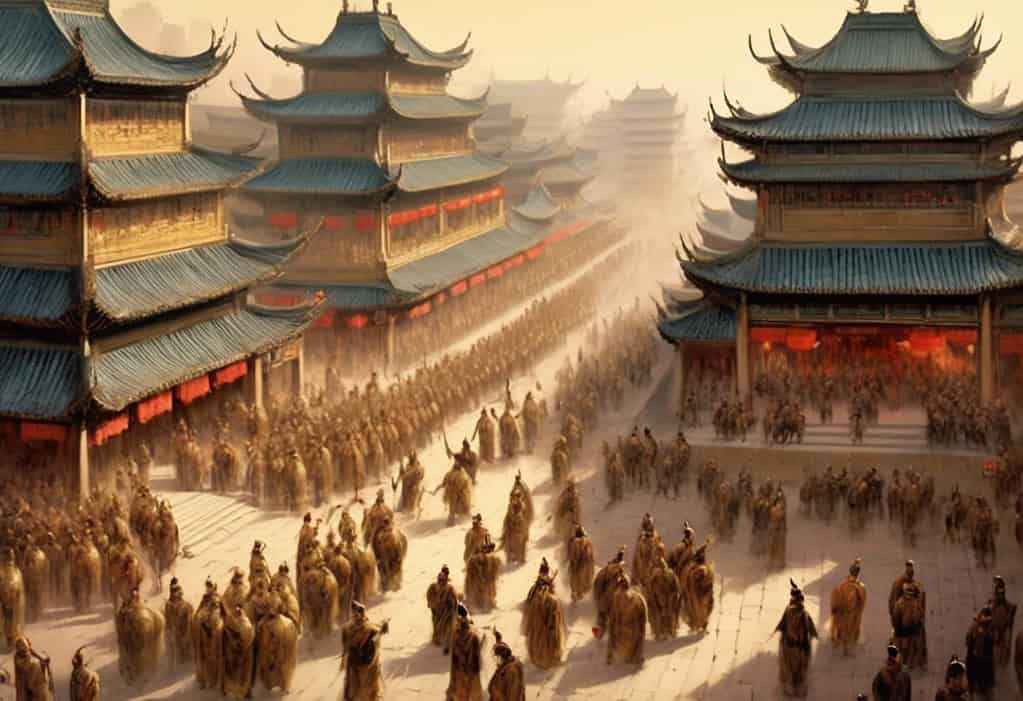The Zhou Dynasty ruled ancient China from 1046 to 256 BCE. It was a time of significant cultural and technological advancements. The dynasty is divided into two main periods: the Western Zhou and the Eastern Zhou. The Western Zhou saw the establishment of a centralized government, while the Eastern Zhou was marked by social unrest and the rise of powerful regional states. The Zhou Dynasty is known for its contributions to Chinese philosophy, literature, and art.
Summary List
- The Zhou Dynasty ruled ancient China from 1046-256 BCE.
- It was the longest ruling dynasty in Chinese history.
- The Zhou Dynasty introduced the concept of the Mandate of Heaven.
- Confucius, a famous Chinese philosopher, lived during the Zhou Dynasty.
- The Zhou Dynasty eventually fell due to internal conflicts and invasions from nomadic tribes.
Games And Apps
Learning Modules
Establishment of the Zhou Dynasty (1046 BCE)
The Zhou Dynasty, established in 1046 BCE, marked a significant shift in Chinese history with its introduction of the Mandate of Heaven concept. This era saw the rise of powerful rulers and advancements in agriculture, metallurgy, and philosophy, setting the stage for a golden age of Chinese civilization.
I Want To Learn This!Battle of Muye (1046 BCE)
The Battle of Muye in 1046 BCE was a pivotal moment in Chinese history, marking the overthrow of the Shang dynasty by the Zhou. Led by King Wu, the Zhou forces defeated the tyrannical Shang ruler, establishing a new era of civilization and culture in ancient China.
I Want To Learn This!Duke of Zhou’s Regency (1042 BCE)
In 1042 BCE, the Duke of Zhou, a legendary figure in Chinese history, assumed regency over the Zhou dynasty after the death of King Wu. Known for his wisdom and benevolent rule, the Duke of Zhou's regency marked a period of stability and prosperity for the ancient Chinese kingdom.
I Want To Learn This!Consolidation of the Feudal System (1042 BCE)
In 1042 BCE, the consolidation of the feudal system brought about a shift in power dynamics, as kings and nobles solidified their control over land and resources. This period marked a turning point in medieval society, shaping the structure and hierarchy that would dominate for centuries to come.
I Want To Learn This!Creation of the Rites of Zhou (1035 BCE)
The Creation of the Rites of Zhou is an ancient Chinese text dating back to 1035 BCE. This influential work outlines the rituals and protocols for governing a society, providing insight into the political and social structure of early Chinese civilization. Its principles continue to shape Chinese culture and governance today.
I Want To Learn This!Zhou Dynasty's Golden Age (1027 BCE - 771 BCE)
During the Zhou Dynasty's Golden Age, China experienced a period of peace, prosperity, and cultural advancement. Innovations in technology, art, and philosophy flourished, laying the foundation for Chinese civilization. The dynasty's centralized government and agricultural advancements led to economic growth and social stability.
I Want To Learn This!King Wu’s Death and King Cheng’s Ascension (1043 BCE)
In 1043 BCE, King Wu of Zhou passed away, leaving his young son, King Cheng, to ascend to the throne. As the new ruler, King Cheng faced the daunting task of maintaining his father's legacy and navigating the challenges of leadership in ancient China.
I Want To Learn This!Construction of the Western Zhou Capital, Haojing (1027 BCE)
Constructed in 1027 BCE, the Western Zhou Capital of Haojing was a magnificent city that symbolized the power and authority of the Zhou dynasty. With its elaborate palaces, temples, and city walls, Haojing was a testament to the advanced architectural and engineering skills of the ancient Chinese civilization.
I Want To Learn This!Defeat of the Shang Dynasty (1046 BCE)
The defeat of the Shang Dynasty in 1046 BCE marked a pivotal moment in Chinese history. With the rise of the Zhou Dynasty, a new era of cultural and political transformation began. This event reshaped the course of China's civilization and set the stage for centuries of dynastic rule.
I Want To Learn This!Zhou Dynasty's Expansion (1046 BCE - 771 BCE)
The Zhou Dynasty's expansion marked a period of significant territorial growth and cultural influence in ancient China. From their capital in Haojing, the Zhou rulers extended their power and authority over neighboring states, shaping the course of Chinese history for centuries to come.
I Want To Learn This!Oracle Bones Inscriptions (1046 BCE - 771 BCE)
Oracle Bones Inscriptions are ancient Chinese scripts carved onto animal bones and shells, used for divination and communication with ancestors. Dating back to the Shang dynasty (1046-771 BCE), these inscriptions provide valuable insights into early Chinese civilization, including religious beliefs, social structures, and political practices.
I Want To Learn This!Zhou Dynasty's Political Reforms (1027 BCE - 771 BCE)
During the Zhou Dynasty (1027 BCE - 771 BCE), political reforms were implemented to establish a centralized government. The dynasty divided its territory into smaller administrative units and created a system of feudalism to maintain control over vassal states. These reforms laid the foundation for centuries of Chinese governance.
I Want To Learn This!King Wen's Contributions to the Dynasty (1099 BCE - 1050 BCE)
King Wen of the Zhou Dynasty made significant contributions to his kingdom during his reign from 1099 BCE to 1050 BCE. He is credited with developing the concept of the Mandate of Heaven and laying the groundwork for the eventual overthrow of the Shang Dynasty. His legacy continues to influence Chinese political thought to this day.
I Want To Learn This!Duke of Zhou's Contributions to the Dynasty (1042 BCE - 1035 BCE)
The Duke of Zhou, a key figure in Chinese history, made significant contributions to the Zhou Dynasty from 1042 BCE to 1035 BCE. Known for his wisdom and political acumen, he played a pivotal role in stabilizing the kingdom, implementing social reforms, and laying the foundation for a prosperous era.
I Want To Learn This!Decline of the Western Zhou Dynasty (771 BCE - 256 BCE)
The Decline of the Western Zhou Dynasty marked a period of political turmoil, social unrest, and external threats that ultimately led to the downfall of one of ancient China's most powerful dynasties. As internal divisions and external invasions grew, the once mighty Zhou empire crumbled, paving the way for new powers to rise.
I Want To Learn This!












